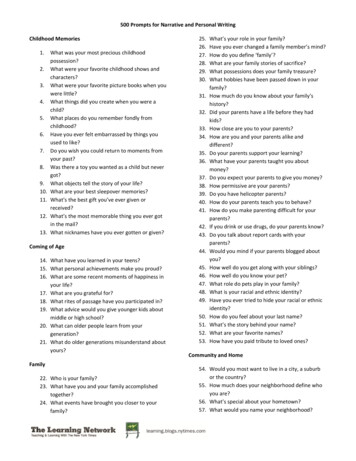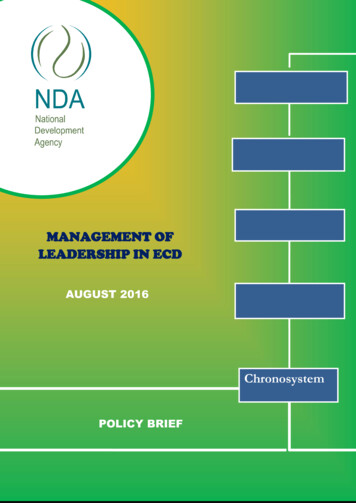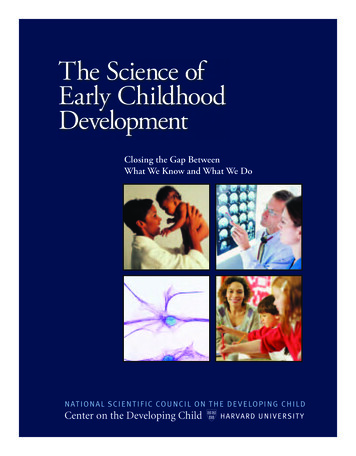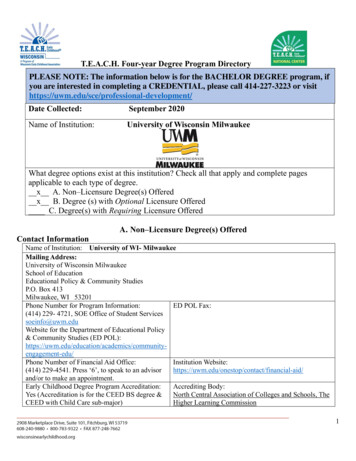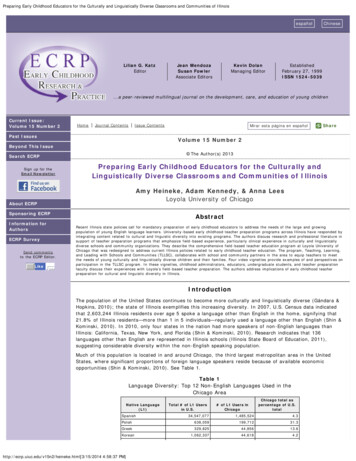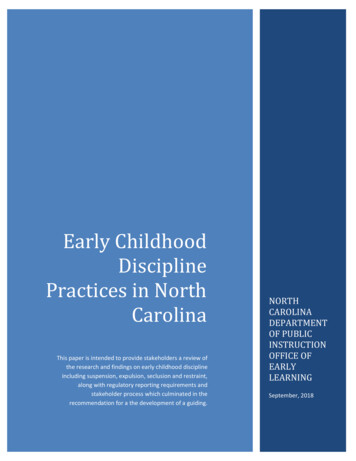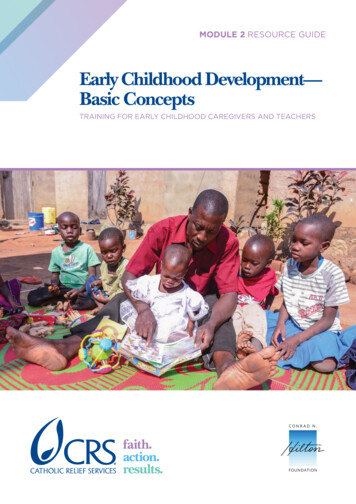
Transcription
MODULE 2 RESOURCE GUIDEEarly Childhood Development—Basic ConceptsTRAINING FOR EARLY CHILDHOOD CAREGIVERS AND TEACHERS
MODULE 2 RESOURCE GUIDEEarly Childhood Development—Basic ConceptsTRAINING FOR EARLY CHILDHOOD CAREGIVERS AND TEACHERSEARLY CHILDHOOD DEVELOPMENT—BASIC CONCEPTSi
This guide is part of a series of manuals that focuses on six topics in EarlyChildhood Development (ECD): different programming approaches, basic concepts,assessments, early childhood environments, children with special needs and childprotection, and the health, safety and nutrition of young children. The series wasprepared within a three-year CRS-led project called “Strengthening the Capacity ofWomen Religious in Early Childhood Development,” or “SCORE ECD.” Fundedby the Conrad N. Hilton Foundation, the project helps Catholic sisters in Kenya,Malawi, and Zambia in their work with children aged 0-5 years and their families.The project is being implemented from January 2014 to December 2016.CRS referred to a wide range of documents in preparing this curriculum. Please see “Reference Documents”section in Module 1 facilitator or resource guide for the full list.Written by Selamawit Tadesse, in cooperation with CRS SCORE ECD team.Edited by David SnyderCover photo: Lawrence Gervais, 40, and Elizabeth Simon, 38, have created a home space for their childrenwhere they can apply the early childhood development skills they’ve learned from a CRS project fundedby the Hilton Foundation in Geita, Tanzania. Lawrence was selected by CRS and the local diocese as a “rolemodel” male, to be an example for other men and women in the village. Philip Laubner/CRSCopyright 2016 Catholic Relief ServicesAny reproduction, translation, derivation, distribution or other use of this work is prohibited without theexpress permission of Catholic Relief Services (“CRS”). Please obtain permission from pqpublications@crs.org or write to:Catholic Relief Services228 West Lexington StreetBaltimore, MD 21201-3443 USA
Table of ContentsRESOURCE GUIDE 2: INTRODUCTION TO EARLY CHILDHOOD DEVELOPMENT .VPurpose.vSESSION 1: INTRODUCTION TO EARLY CHILDHOOD DEVELOPMENT . 1Learning objectives.1Early childhood development and its benefits.1The benefits of investing in early childhood development .2Factors influencing child development.4Domains of child development and the concept of the “Whole Child”.7Setting goals for supporting all areas of children’s development .7SESSION 2: DEVELOPMENT AND INTERVENTION OF INFANTS AND TODDLERS.21Learning objectives. 21The beginning of child development. 21Safe delivery and the newborn child. 24Attachment and its importance in the early stage of child development . 26Quality caregiving and developmental milestones of infants and toddlers.30Milestones and fostering the development of infants and toddlers . 32Guidance and discipline: Responding to challenging behaviors of toddlers. 41SESSION 3: DEVELOPMENT AND INTERVENTION OF PRESCHOOL-AGEDCHILDREN .45Learning objectives. 45Special characteristics of preschool-aged children. 45The role of a preschool teacher .46Developmental milestones and fostering preschoolers’ development.48Guidance and discipline: Supporting positive behavior of preschoolers. 54REFERENCES.67EARLY CHILDHOOD DEVELOPMENT—BASIC CONCEPTSiii
RESOURCE GUIDE 2: INTRODUCTION TO EARLY CHILDHOOD DEVELOPMENTResource Guide 2 is one of six ECD Resource Guides from the CRS SCORE ECD curriculum.The six series are:1.Approaches to Early Childhood Programs2.Introduction to Early Childhood Development3.Assessing Young Children’s Development4.Quality Early Childhood Environments for Young Children5.Children with Special Needs and Child Protection6.Health, Safety, and NutritionSAMPLE REVIEW“This curriculum is very comprehensive and inclusive. Furthermore, it is verysimple to understand; one can even just read it and use it. As long as you knowEnglish, you do not need a tutor to take you through it. You can just go thoughit on your own!” (Reviewer: CRS SCORE ECD Coordinator/Association of SistersKenya (AOSK), April, 2015)“The age group 0-2, which is a gap in the Zambia government ECD policy, is wellcovered in this curriculum. We have been equipped with knowledge and skills onhow to deal with this unique age group, which is very critical in human development.Infants, toddlers, persons with disabilities and children with HIV need appropriateinterventions to fully grow and develop. How this is done is covered in thiscurriculum.” (Reviewer: Member of the CRS SCORE ECD Project Curriculum ReviewTeam, Kenya, April, 2015)“The counseling card and the child behavior modification techniques are missingin the Zambia government curriculum; and we found the caregiver counseling cardand the guidelines for disciplining young children very helpful techniques. Welearned that discipline means teaching and not punishing children and the behaviormodification tips are helpful.” (Reviewer: Master Trainer/sister, CRS SCORE ECDZambia, July, 2015)ivMODULE 2 RESOURCE GUIDE
Resource Guide 2:Introduction to EarlyChildhood DevelopmentPURPOSEThe purpose of this guide is to provide information on basic concepts of EarlyChildhood Development (ECD), including its components, importance, the agerange classification of ECD, and the expected pattern of children’s developmentalskills in all areas of development--physical-motor, social-emotional, spiritual-moral,and cognitive-language development. Further topics include the importance ofattachment in child development, ability differences among infants, toddlers, andpreschoolers, and the need for caregivers to differentiate their support accordingto children’s individual interests and developmental levels, including shaping thebehavior of children through positive care and guidance in partnership with families.This guide is divided into three sessions:1.Session one describes the early childhood period, childhood development, andhow investment in early childhood benefits children and society. Further topicsinclude factors influencing child development, how development takes place,domains of child development, and ways in which caregivers and teachers canwork with families and set appropriate developmental and learning goals forchildren, including children with special needs.2. Session two describes the importance of maternal and newborn care and explainshow a caregiver/ child early attachment relationship lays a foundation for childdevelopment. The developmental milestones specific to infants and toddlers inareas of physical-motor, social-emotional, spiritual-moral, and cognitive-languagedevelopment are also discussed. Further topics include how caregivers andteachers can foster learning and prosocial behaviors for this age group of children.3. Session three describes the special characteristics of preschool-aged children,including their milestones in physical-motor, social-emotional, spiritual-moral, andcognitive-language development. In addition, ideas on how to foster learning andprosocial behaviors for this age group are provided.EARLY CHILDHOOD DEVELOPMENT—BASIC CONCEPTSv
Session 1: Introduction to EarlyChildhood DevelopmentLEARNING OBJECTIVESBy the end of this session, participants will be able to: Describe the meaning and benefits of Early Childhood Development. Discuss factors influencing child development. Describe the main domains of child development. Set appropriate learning and development goals to meet the needs of children in eachdomain of development, including fostering development for children with disabilities. Identify strategies caregivers can use to help families support their children’s needs.EARLY CHILDHOOD DEVELOPMENT AND ITS BENEFITSDEFINITION OF EARLY CHILDHOODGenerally, early childhood is defined as a time that “spans the prenatal period to eightyears of age and it is the most intensive period of brain development throughout thelifespan” (WHO & UNICEF, 2012). This period is the most critical time for the growthand development of the child and needs the utmost attention and appropriate care.This guide describes only the early childhood development of children from birth tofive years of age.Early childhood development is defined with many different terminologies bydifferent programs or institutions. Here is how the ECD policy documents of thegovernments of Malawi, Kenya, and Zambia define early childhood.EARLY CHILDHOOD DEVELOPMENT—BASIC CONCEPTS1
Government of Malawi: Early childhood care and development is a “comprehensive approach topolicies and programs for children from conception to eight years. It encompasses early learning andstimulation, health, education, nutrition, hygiene, and sanitation.” (National Strategic Plan for EarlyChildhood Development, 2008, Government of Malawi).Government of Kenya: Early childhood care and development is a “framework that targets all childrenincluding the vulnerable and marginalized from conception to eight years of age and all these childrenhave the same needs which consist of nutrition, health, nurture, protection, stimulation, and training ”(National Early Childhood Development Policy Framework, Republic of Kenya, June 2006).Government of Zambia: Early childhood care and development is a provision of support “for everyyoung child to realize his/her right to survival, to protection, and to care that will ensure optimalphysical and psychosocial development from birth to age eight including infant stimulation, healthand nutrition, early childhood education, community development ” (National Policy of Zambia onEarly Childhood Care, Development, and Education: Investing into Our Children’s Future, Everyone’sResponsibility, 1st Draft by Mulenga, n.d.).Commonly used early childhood terminology“Early Childhood Education (ECE), Early Childhood Care and Education (ECCE), Early Childhood Care(ECC), Early Childhood Care and Development (ECCD), and Early Childhood Care for Development”(WHO & UNICEF, 2012).THE BENEFITS OF INVESTING IN EARLY CHILDHOODDEVELOPMENTThe early childhood period is the basis for later success in life. It is the time when achild’s brain develops at a rapid rate creating plenty of opportunities for children’learning and development. A child can have a good start in life when he/she growsup in a nurturing and stimulating environment that meets his/her essential needssuch as nutrition, health, and safety, as well as the psychological, social, spiritual, andintellectual needs. This also means that the child has a greater chance of reachinghis/her full potential later in life. Therefore, it is important to address children’s needsholistically because the absence of one or more essential needs can lead to negativedevelopmental outcomes for children.Each and every child has a right to early childhood development. The United NationsConvention on the Rights of the Child Article 6 (Article 6, UNICEF) highlights thatthe child has “a right to live and develop healthy” and that every child has “the rightto a standard of living that is good enough to meet their physical and mental needs”(Article 27, UNICEF) http://www.unicef.org/crc/files/Rights overview.pdf.The ECD policies of Kenya, Malawi, and Zambia recognize that investment in theearly years of life has multiple return values to the development of both children andsociety. For example, Kenya’s national ECD policy document (June, 2006, pp. 2-4)states the benefits of investing in early childhood development as follows:Brain development: The development of the brain is most rapid during the first threeyears of life. Quality early childhood stimulation, nutritional support, and nurturance2MODULE 2 RESOURCE GUIDE
enhances the development of the brain. Lack of a responsive and sensitive caregivingcan seriously affect the child’s development, and cause failure to thrive.Early identification and intervention: Investment will be spent not only to deliveroutcomes but to also reach the children who need it most. Therefore, children withdisabilities and vulnerable children who are socially marginalized and discriminatedagainst will have opportunities for early detection and intervention which ensureschild’s survival, health, growth, and psycho-social and intellectual development.School readiness: All children, regardless of their sociocultural background, will haveequal opportunity to enter school at their appropriate age. The opportunity to helpdisadvantaged children attain an equal start in schooling is in the early years of life.The experiences of early years help young children to build their competence inall areas of development; the physical-motor, the social-emotional, the cognitivelanguage and the moral-spiritual, including a positive attitude towards learning.Cost savings for society: A quality early childhood environment and education willtranslate into better health, fewer illnesses, good academic skills, and fewer schooldrop outs and repetition, preparing the child to become a productive citizen. Familiesand social services will have less cost in child care and intervention and invest in otherfamily or national development programs.Poverty reduction: Quality early childhood development experiences and educationlead to better success in school, which in turn prepares the child to become an adultwith higher employment and earnings, better health, and lower levels of dependencyon families and society as well as lower crime rates compared to children who don’thave these opportunities.BRAIN DEVELOPMENT IN CHILDREN AND WAYS TO IMPROVE NEURAL CONNECTIONS1New research in brain development shows that: The baby’s brain starts to develop soon after conception and the brain cells arepresent at birth. Most of the neurological cell connections are made during the first three years of life.By three years of age, a child’s brain is twice as active as an adult’s brain. The care and experiences a child has within the first three years determine thecapacity of the brain to develop. Caregivers and early childhood teachers playan important role in helping children form strong brain connections. Early brainstimulation has increased significance for vulnerable children who are exposed toviolence and trauma, inadequate nutrition, and toxic environments.Below are some ways parents and teachers can help children’s brains makeneural connections: Pregnant women need to eat nutritious food and not take drugs or alcohol to makesure the baby is born healthy. Give babies breast milk or iron-fortified baby formula to feed their brains with good food. Create safe places for them to play. Talk to children to help them learn about language and communication. Read to children. Sing songs with children. Dance with children.1Britto in Conrad N. Hilton Foundation Human Sciences Research Council Newsletter (13 July, 2014); CRS,Lesotho (2012); Fox, Levitt, & Nelson (2010); thelancet.com.EARLY CHILDHOOD DEVELOPMENT—BASIC CONCEPTS3
Provide opportunities for children to play outside. Encourage children to explore through their senses. Comfort children when they are upset.PERIODS OF EARLY CHILDHOODThe early childhood period is categorized from birth through age eight(Charlesworth, 2012).Infancy:Birth to one yearToddlerhood:One to three yearsPreschool age:Three to five yearsKindergartners:Five to six yearsPrimary:Six to eight years[Note: Different programs classify the early childhood period according to their owncontext. Therefore, it is recommended that users of this guide refer to their own earlychildhood development national policy guidelines when planning and implementingearly childhood programs.]WHAT IS GROWTH?Growth refers to a process of change in the child’s physical body and size. Someexamples of growth are a child’s height, weight, head circumference, shoe size, lengthof arms and legs, and body shape.WHAT IS DEVELOPMENT?Development begins at conception. It refers to a child’s ability to do more challengingthings as they get older. These skills allow a child to become independent (e.g.,physical development of large and small motor skills to sit, crawl, hold objects etc.)and develop with age.HOW DOES DEVELOPMENT TAKE PLACE?Development takes place in a predictable manner and all children (e.g., childrenwith or without disabilities) follow a similar sequence of development but grow attheir own rate. For example, children crawl before they stand; they stand and walkbefore they eventually run. Developmental milestones help us to check how a childprogresses in his/her development.FACTORS INFLUENCING CHILD DEVELOPMENT2Important: Development is influenced by heredity, environmental factors, culture, andfamily values unique to each individual. The growing child affects his/her environmentand the environment affects the growing child (e.g., abilities, personalities, objects,families, social values, culture).24CRS, Lesotho (2012).MODULE 2 RESOURCE GUIDE
INDIVIDUAL DIFFERENCE AND ITS INFLUENCE ON CHILD DEVELOPMENTTeachers and caregivers need to understand that each child is unique and hasdifferent needs and styles of learning. This will help teachers to plan activities that areappropriate for each child’s learning and development needs. Children inherit physical characteristics from their parents through their genes (e.g.,skin, hair and eye color, height, gender). Children develop and grow at different rates. Some children grow more rapidlythan others. Children belong to families with their own culture, language, and traditions. Children are born with different personalities and they respond to people andsituations in different ways. For example, some children can be irritable, easygoing, orindifferent to outside stimulation. Children explore roles related to their gender; e.g., girls mimic their mothers and boystheir fathers. Children have different interests and often follow them over a length of time. Children have preferred ways of learning called learning styles: Auditory learners learn best by listening and being told about things. Visual learners learn best when they are shown how to do things. Kinesthetic learners learn best by moving and doing practical things. Children have different life experiences. Some children may have ill health or adisability, or a member of their family may be chronically ill. Some children who live in dire poverty may experience neglect. Teachers need to take individual differences into account when planning anappropriate program for young children.ENVIRONMENT AND ITS INFLUENCE ON CHILD DEVELOPMENTChildren begin to grow and develop from the moment they are conceived. Theirgrowth and development is based on a number of factors: Children inherit characteristics from their parents (e.g., height, skin and eye color,gender, blood type and temperament). Sometimes, medical conditions anddisabilities are also inherited. Genetic differences in other children may cause a child to look different. A child can be affected by what happens before birth. If the mother is infected withHIV, she can pass this on to her unborn baby. The effects of alcohol, nicotine, anddrugs can delay development. The family is the most important factor in a child’s development. All children needthe attention of a warm and loving family, to feel safe and to have their basic needsmet. A child who is neglected, abused or separated from his loved ones may failto grow and develop. Some children may live in several different family structuresduring childhood and find it difficult to form close and trusting relationships withtheir families or caregivers. The environment in which children grow up plays a huge part in their development.An important way to support children’s healthy brain development is to provide asafe and happy environment for them to grow up in, yet many young children livein unsafe communities. Some children are exposed to abuse or neglect, which hasprofound and long term effects on their development. Poverty can negatively affect children in many ways. Families often have to live onvery little money due, for example, to unemployment, sickness, or disability. Theymay not have enough money for food, clothing or proper housing and sanitation.EARLY CHILDHOOD DEVELOPMENT—BASIC CONCEPTS5
These problems often create stress amongst family members, which children cansense and be affected by. Children need nutritious food to grow and stay healthy. A child living in povertymay also suffer from poor nutrition, which in turn affects his ability to concentrateand learn. Children need enough sleep for their growth and development. They need sleep to restfrom the day’s activities and to wake up full of energy for the next day’s activities. Cultural background influences development. There are different values and practicesabout the way things are done and how children should behave. For example, insome cultures boys and men are not supposed to cry and children are not allowed toexpress their anger. Some disabilities (but not all) will pose obstacles for children to learn. For example,a child who was born without an arm and is considered to be capable will find otherways of doing things independently, like playing and learning. Activities can often beadapted to suit a child’s special needs. For example, a toy can be adapted to make iteasier to grip, or a table can be lowered to make it possible for a child to participatein an activity. Children with disabilities are likely to be exposed to social stigma and exclusion,discrimination, and institutionalization because of their disabilities. All of thesefactors are damaging to child development and can cause developmental delay andirreversible psychological harm to young children. Children with disabilities thrivewhen they grow up within a family setting--whether biological, adoptive, or foster. Some children have health conditions that may affect their development. A sick childmay miss out on opportunities to play and learn. Sometimes, parents may have chronic health conditions that will prevent them fromengaging in some types of play, and it may reduce interaction between child andparents. Examples of chronic health conditions include diabetes, cancer, asthma,allergies, HIV, etc. Children who are infected with or affected by HIV are exposed to a number of factorsthat can affect their growth and development: HIV is a virus that can negatively affect the development of the child’s centralnervous system. A child with HIV may not grow normally, be slow to reachdevelopmental milestones, or experience learning or language problems. He/shemay also lose previously gained milestones. Children with HIV and AIDS may get sick more often or have less energy tolearn. They will also miss out on opportunities to play with other children andmake friends. In many cases, at least one of the child’s parents will be infected with HIV as well.One or both parents may fall ill or die, which adds to their emotional distress. Children who are not HIV positive themselves are also affected. They may have todeal with the loss of their parents or have to care for sick family members. Manychildren are separated from their families and have to live with other relatives,foster parents, or in a children‘s home. Children and their families may be stigmatized and discriminated against becauseof their HIV status or that of a family member.6MODULE 2 RESOURCE GUIDE
DOMAINS OF CHILD DEVELOPMENT AND THE CONCEPT OFTHE “WHOLE CHILD”3Children grow and develop in different domains of development and they are: Physical and motor development Spiritual and moral development Social and emotional development Cognitive and language developmentThe above areas of development are interrelated and affect each other; therefore,addressing the whole child requires the consideration of each area of development.The skills a child acquires are influenced by his/her different developmental abilities.This means social upbringing influences caregiver/child relationships; cognitivebehaviors promote or limit social skills, and physical activities impact language andthought processes.For example, why do some children have good social skills? It is because they areliked by their peers and they get along with them. To get along with and be acceptedby peers, a four-year-old child may: Show many talents such as competence in movement activities (e.g., running,jumping, climbing), building blocks/structures, (physical-motor skills). Show care for others, collaborate, and take leadership in planning games (socialemotional; cognitive skills). Describe events with clear expressions of thought (language and cognitive skills).SETTING GOALS FOR SUPPORTING ALL AREAS OFCHILDREN’S DEVELOPMENT4Below is a broad description of each developmental domain as well as a set ofeducational goals that describe what teachers can expect young children to knowand be able to do. These goals will help caregivers and teachers plan activities thatwill support all areas of children’s development.PHYSICAL AND MOTOR DEVELOPMENTPhysical and motor development describes how children’s bodies grow anddevelop and how they learn to control the movements of their bodies. This domainhas two parts:1.The physical growth of the child such as size, weight, and height.2. The large and small motor skills that a child uses to do things.Physical development: For healthy physical development children need nutritiousfood and clean water, regular exercise, enough sleep and rest, healthcare when theyare sick, and to complete the immunization schedule so that they are protectedagainst diseases.Motor development: The large motor skills of a child are crawling, walking, running,skipping, climbing, hopping, and jumping. The small motor or fine motor skills ofa child are the use of the hands and fingers to handle or pick up objects such as aspoon, toy, or crayon. Children use their eyes to coordinate their movements andhandling of objects, and this is called hand-eye coordination.3Copple & Bredekamp (2009); Marotz & Allen (2013); Senefeld (2014).4Catron & Allen (2008); CRS, Lesotho (2012).EARLY CHILDHOOD DEVELOPMENT—BASIC CONCEPTS7
Development and learning goals for young children in the area of physicaldevelopment include: Learning how to move their large muscles and feel confident about what their bodiescan do. Learning how to control the small muscles in their hands and fingers and developtheir hand-eye coordination. Being healthy and physically fit.Physical development is about how children‘s bodies grow and develop and howchildren learn to control the movements of their bodies. Growth is the physicalchange in children’s height and weight.During the first two years of life a child’s growth in height and weight is very rapid.For example, by the time a child is two years old, he/she should have already reachedhalf of his adult height.For healthy physical development children need nutritious food and clean water,regular exercise, enough rest, and healthcare when they are sick. They need safe,clean, and open spaces, as well as time and encouragement to explore these anddevelop their physical skills.Children also need to complete the immunization schedule so that they are protectedagainst diseases. As children grow, it is important to check that they are growing anddeveloping as they should, so that if there are any concerns these can be managedas early as possible. This means regularly weighing children to see if they are gainingenough weight for their age.Physical development follows a natural progression, for example: Control of head movements happens before control of leg movements. Muscle development proceeds from the center of the body outwards. This meansthat control of the head, upper body, and arms happens before control of the handsand fingers.Motor development involves skill in using the body parts. There are two types ofmotor skills: The large muscle skills The small muscle skills1.Large muscle skills: Children need to move the different large muscles in theirbodies so that they can do things like crawling, walking, running, skipping, climbing,hopping, and jumping.2. Small muscle skills: Children need to control the small muscles in their hands andfingers to handle things like a spoon or a crayon, or to pick up an object. Theseskills are important for learning to write.8MODULE 2 RESOURCE GUIDE
Small muscle skills also help children to do things for themselves, like feeding anddressing. These activities involve developing the abilit
and development of the child and needs the utmost attention and appropriate care. This guide describes only the early childhood development of children from birth to five years of age. Early childhood development is defined with many different terminologies by different programs or

